A drafting compass, also known as a technical compass, is an essential tool for architects, engineers, and anyone involved in technical drawing or drafting. This instrument is used to draw circles or arcs in technical and engineering drawings, providing precision and accuracy that cannot be achieved by freehand drawing. The drafting compass has been a staple in the field of technical drawing for centuries, and its importance remains undiminished in the digital age.
While the basic function of a drafting compass is straightforward, the tool itself can be complex, with different types and features designed for specific tasks. Understanding these variations is crucial for anyone who uses a drafting compass in their work or studies. This article will provide a comprehensive guide to drafting compasses, covering everything from their importance and types to key features, material quality, and more.
Whether you’re a professional architect or an engineering student, a quality drafting compass is an investment that can enhance your work. By understanding the intricacies of this tool, you can make an informed decision when purchasing a drafting compass and ensure that it serves your needs effectively and efficiently.
Our Top Drafting Compass Picks
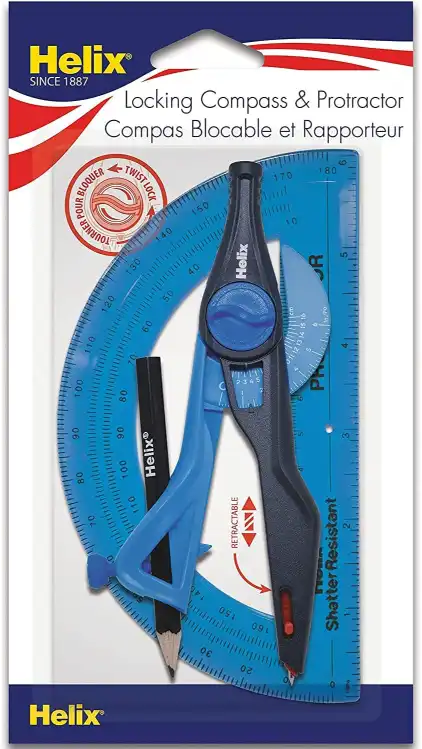
Maped Helix Plastic Locking Compass and Protractor Set
Check on AmazonKey Specs:
- Compass Locking Mechanism: Twist-lock for secure, accurate use
- Material: Durable plastic for lightweight use
- Measurement Units: Graduated in both inches and metric
- Maximum Circle Size: 12 inches
- Protractor Size: 6 inches (15 cm)
The Maped Helix Plastic Locking Compass and Protractor Set is a highly functional tool for precision in geometry, drafting, and drawing. The twist-lock feature ensures the compass legs stay securely in place for accurate circle drawing. Its ergonomic design fits comfortably in your hand, and the retractable tip makes for safe storage. The dual-measuring units in both inch and metric enhance versatility, while the compass can create circles up to 12 inches in diameter. This set includes a 6-inch shatter-resistant protractor for added value.
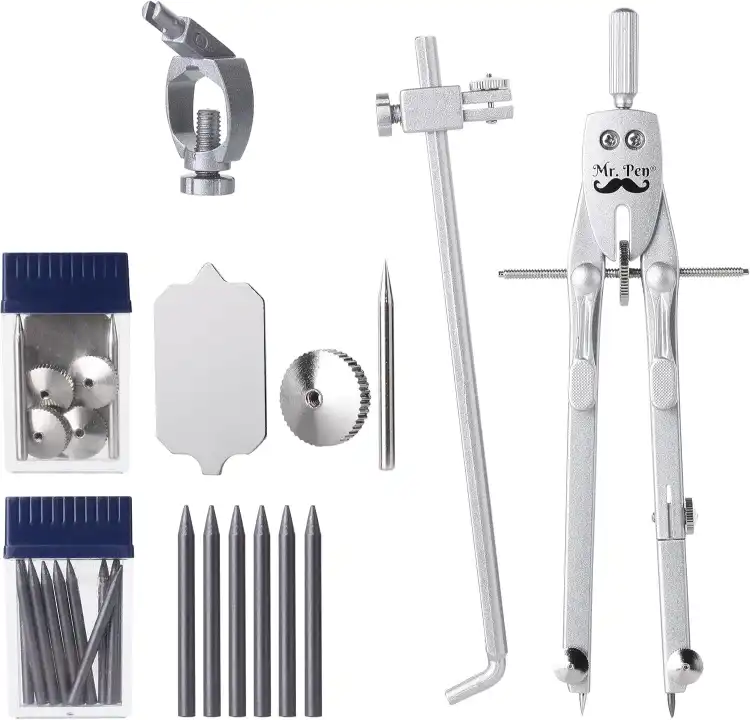
Mr. Pen- Professional Metal Compass
Check on AmazonKey Specs:
- Maximum Circle Size: 18 inches in diameter
- Material: Durable metal construction
- Adjustability: Quick-setting push-button mechanism
- Includes: Extension beam, universal adapter, extra leads, spare needle, screws, and screwdriver
- Storage: Comes with a clear, reusable pouch for easy storage and transport
The Mr. Pen Professional Metal Compass is a standout tool for anyone needing precision in geometry, drafting, or art projects. The center wheel and spring bow head ensure smooth operation, while the quick-setting adjustment with the push-button mechanism eliminates accidental leg movement. This compass can draw circles up to 18 inches in diameter, making it incredibly versatile. The included extension beam and universal adapter add flexibility, and with extra leads, a spare needle, screws, and a screwdriver, it’s fully equipped for long-term use.
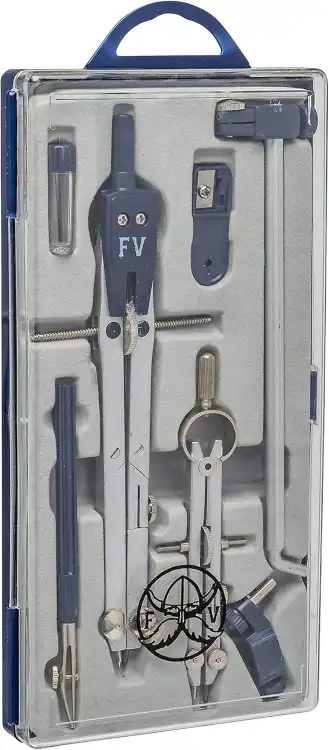
Ferocious Viking Drafting Compass
Check on AmazonKey Specs:
- Circle Diameter: Up to 22 inches
- Material: High-quality plastic construction
- Includes: 2 compasses, extension beam, lead sharpener, stylus pen, and lead container
- Ideal for: Geometry, drafting, architectural, and engineering work
- Usage: Perfect for creating geometric shapes and bisecting angles
The Ferocious Viking Drafting Compass Set is a fantastic tool for anyone needing precision in geometry, drafting, and architecture. The high-quality bow compass features a set screw for accurate circle sizing and a large extension beam that allows you to draw circles up to 22 inches in diameter. The stylus pen and lead sharpener add extra convenience, ensuring continuous sharpness for precise arcs. Whether for school, drafting, or engineering projects, this set delivers reliability and flexibility in every use.
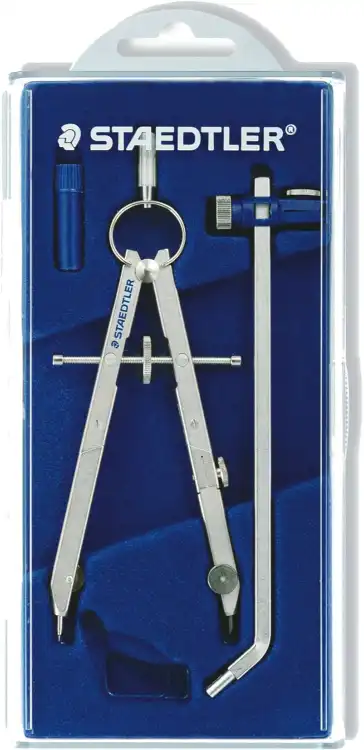
Staedtler Mars Comfort, Professional Drafting, Drawing Compass
Check on AmazonKey Specs:
- Material: Durable metal construction
- Circle Diameter: Up to 10.5 inches (standard), 19.5 inches (with extension arm)
- Includes: Extension arm, two needle heads, spare leads
- Adjustments: Micro-step adjustment wheel for precise diameter
- Packaging: Comes with a sturdy hinged plastic case for storage
The Staedtler Mars Comfort compass is an exceptional tool for professionals requiring precision. This metal drafting compass features a comfort grip for easy handling and a micro-step adjustment wheel that locks in the exact circle size, making it ideal for architects, engineers, and artists. It draws circles up to 19.5 inches with the extension arm, ensuring versatility. The inclusion of spare leads and two needle heads adds to its practicality, while the sturdy plastic case keeps everything organized.
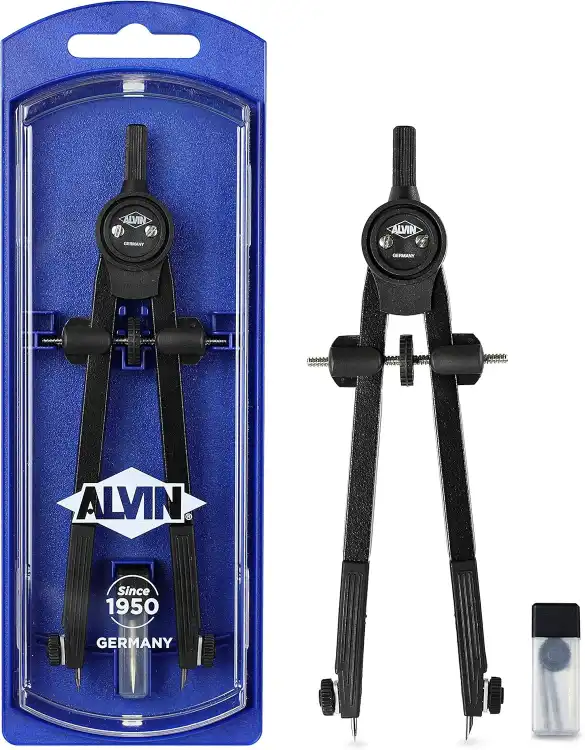
Alvin, Introductory Bow Compass
Check on AmazonKey Specs:
- Material: Fiberglass with matte silver zinc
- Diameter Capacity: Up to 12 inches
- Design: Compact and easy-to-use
- Packaging: Comes in a hard, see-through plastic case
- Ideal for: Students, artists, and professionals
The Alvin Introductory Bow Compass is a reliable and easy-to-use tool for anyone, from students to professionals. Crafted from durable fiberglass and matte silver zinc, this compass offers smooth operation and precision. It comfortably draws circles up to 12 inches in diameter, making it ideal for geometry, drafting, and engineering tasks. The compact design and inclusion of a hard plastic case ensure portability and storage convenience. Perfect for both students and hobbyists, it’s an essential tool for accurate drawings and designs.
Understanding the Importance of a Drafting Compass
The drafting compass is more than just a tool for drawing circles. It’s a precision instrument that plays a crucial role in creating accurate and detailed technical drawings. Whether you’re designing a building, a machine part, or a circuit diagram, the drafting compass allows you to create precise geometrical shapes and measurements that are essential for the successful implementation of your design.
Furthermore, the drafting compass is not just important for the creation of technical drawings. It’s also a vital tool for understanding them. By using a drafting compass, you can accurately interpret the dimensions and proportions in a technical drawing, ensuring that the design is implemented correctly in the real world. This is particularly important in fields like architecture and engineering, where a small error in interpretation can lead to significant problems in construction or manufacturing.
Finally, the drafting compass is an important tool for learning and teaching technical drawing. By using a drafting compass, students can gain a hands-on understanding of geometric principles and learn how to apply them in practical situations. This makes the drafting compass an essential tool not just for professionals, but also for educators and students in fields related to technical drawing.
Different Types of Drafting Compasses
While all drafting compasses serve the same basic function, there are several different types designed for specific tasks. The most common type is the spring bow compass, which has a spring mechanism that allows for easy adjustment of the radius. This type of compass is versatile and suitable for a wide range of tasks, making it a staple in most drafting kits.
Another common type of drafting compass is the divider compass, which is used for measuring distances and transferring measurements from one place to another on a drawing. This type of compass has two sharp points and no pencil holder, making it more suited for measurement tasks rather than drawing.
There are also more specialized types of drafting compasses, such as the drop compass, which has a built-in ink or lead reservoir for continuous drawing, and the beam compass, which has a beam and sliding sockets for drawing large circles. Understanding these different types of drafting compasses can help you choose the right tool for your specific needs.
Key Features to Look for in a Drafting Compass
When choosing a drafting compass, there are several key features to consider. One of the most important is the adjustment mechanism, which allows you to set the radius of the circle you’re drawing. Look for a compass with a smooth and precise adjustment mechanism, as this will allow you to create accurate drawings with ease.
Another important feature is the pencil holder. This should be sturdy and secure, holding your pencil or pen firmly in place while you draw. Some drafting compasses come with a universal holder that can accommodate different types of pens and pencils, while others are designed for specific types of drawing instruments.
The stability of the compass is another crucial feature. A good drafting compass should have a steady and balanced feel, allowing you to draw smooth and consistent circles. Look for a compass with a robust design and high-quality materials, as these factors can greatly affect the stability and performance of the tool.
Material Quality and Durability of Drafting Compasses
The material quality of a drafting compass is a key factor that affects its durability and performance. Most drafting compasses are made of metal, with brass and stainless steel being the most common materials. These metals are durable and resistant to wear and tear, making them ideal for a tool that is often used in demanding conditions.
However, not all metal drafting compasses are created equal. The quality of the metal can vary significantly, with higher-quality metals offering better durability and performance. Look for a compass made of high-grade brass or stainless steel, as these materials are more likely to withstand the rigors of regular use.
In addition to the metal parts, consider the quality of the other components of the compass, such as the adjustment mechanism and the pencil holder. These parts should be made of durable materials and designed to withstand regular use. A high-quality drafting compass is an investment that can last for many years, so it’s worth paying attention to the material quality and durability of the tool.
Precision and Accuracy in Drafting Compasses
Precision and accuracy are crucial in technical drawing, and a good drafting compass should provide both. The precision of a compass refers to its ability to produce consistent results, allowing you to draw circles of the same size every time. This is largely determined by the quality of the adjustment mechanism and the stability of the compass.
Accuracy, on the other hand, refers to the compass’s ability to produce results that match the intended measurements. This is affected by factors such as the sharpness of the points and the fit of the pencil holder. A compass that is not accurate can lead to errors in your drawings, which can have serious consequences in fields like architecture and engineering.
When choosing a drafting compass, look for one that offers both precision and accuracy. Check the quality of the adjustment mechanism, the sharpness of the points, and the fit of the pencil holder. A high-quality compass will provide consistent and accurate results, enhancing the quality of your technical drawings.
The Role of Size and Portability in Choosing a Drafting Compass
The size of a drafting compass can affect its usability and portability. A larger compass can draw larger circles and may offer more stability, but it can also be more difficult to handle and carry around. On the other hand, a smaller compass is more portable and easier to handle, but it may not be suitable for drawing larger circles.
When choosing a drafting compass, consider the size of the circles you typically need to draw. If you often need to draw large circles, a larger compass may be more suitable. However, if portability is a priority, a smaller compass may be a better choice.
Keep in mind that some drafting compasses come with extension beams that allow you to draw larger circles. This can be a useful feature if you need a compact and portable compass that can also handle larger drawings.
Assessing the Comfort and Ease of Use of a Drafting Compass
The comfort and ease of use of a drafting compass are important factors to consider, especially if you use the tool frequently. A comfortable compass is easier to handle and can help you draw more accurately, while a compass that is easy to use can save you time and effort.
When assessing the comfort of a drafting compass, consider the shape and size of the handle, as well as the weight of the tool. A handle that fits comfortably in your hand can make the compass easier to control, while a lightweight compass can reduce hand fatigue during prolonged use.
The ease of use of a drafting compass is largely determined by its design and features. Look for a compass with a simple and intuitive design, as well as features that make the tool easier to use, such as a smooth adjustment mechanism and a secure pencil holder.
Importance of Additional Features: Lock Mechanism, Extension Beam, etc.
While the basic function of a drafting compass is to draw circles, many compasses come with additional features that can enhance their functionality and usability. One such feature is the lock mechanism, which allows you to lock the compass at a certain radius. This can be useful for drawing multiple circles of the same size, as well as for maintaining the radius while you move the compass.
Another useful feature is the extension beam, which allows you to draw larger circles. This can be a valuable feature if you often need to draw large circles, but don’t want to carry around a large compass. Some compasses also come with interchangeable points and pencil holders, allowing you to customize the tool to suit your specific needs.
While these additional features can enhance the functionality and usability of a drafting compass, they can also add to the cost of the tool. When choosing a compass, consider which features are most important to you and whether they are worth the extra cost.
The Role of Brand Reputation in Choosing a Drafting Compass
Brand reputation can play a significant role in choosing a drafting compass. Brands that have a reputation for quality and reliability are more likely to produce high-quality compasses that deliver consistent and accurate results. Furthermore, reputable brands often offer better customer service and warranty coverage, providing additional peace of mind when purchasing a drafting compass.
However, brand reputation should not be the only factor to consider when choosing a drafting compass. While a reputable brand can be a good indicator of quality, it’s also important to assess the specific features and performance of the compass. Even the best brands can produce subpar products, and lesser-known brands can produce high-quality compasses.
When choosing a drafting compass, consider both the reputation of the brand and the specific features and performance of the compass. By doing so, you can ensure that you choose a compass that meets your specific needs and delivers reliable performance.
Price Range and Value for Money in Drafting Compasses
The price of a drafting compass can vary significantly, depending on the brand, features, and quality of the tool. Basic compasses can be quite affordable, while high-end models with advanced features can be quite expensive. When choosing a compass, it’s important to consider not just the price, but also the value for money that the tool offers.
Value for money refers to the balance between the price of the compass and the quality and features it offers. A cheap compass may seem like a good deal, but if it’s poorly made and doesn’t perform well, it’s not good value for money. On the other hand, an expensive compass may seem overpriced, but if it’s well-made and offers advanced features, it could be good value for money.
When choosing a drafting compass, consider both the price and the value for money. Look for a compass that offers the features and quality you need at a price you’re willing to pay. Remember that a high-quality compass is an investment that can last for many years, so it’s worth paying a bit more for a tool that will deliver reliable performance.
Reading and Understanding Product Reviews for Drafting Compasses
Product reviews can be a valuable resource when choosing a drafting compass. They can provide insights into the performance and reliability of the compass, as well as the quality of the customer service and warranty coverage provided by the manufacturer. However, it’s important to read and understand these reviews carefully, as not all reviews are equally reliable.
When reading product reviews, look for reviews that provide detailed and specific information about the compass. Reviews that simply say “great product” or “poor quality” without providing any details are not very helpful. Look for reviews that describe the performance of the compass, the quality of its components, and any issues the reviewer encountered.
It’s also important to consider the source of the reviews. Reviews from professional reviewers or industry experts can be particularly reliable, as these individuals often have a deep understanding of the product and its performance. However, even reviews from regular users can be valuable, as they can provide insights into the everyday use and durability of the compass.
Where to Buy a Quality Drafting Compass: Online vs. Physical Stores
There are many places where you can buy a drafting compass, including both online and physical stores. Each option has its advantages and disadvantages, and the best choice depends on your specific needs and preferences.
Online stores offer a wide range of drafting compasses from various brands, often at competitive prices. They also provide customer reviews and detailed product descriptions, which can help you make an informed decision. However, buying online doesn’t allow you to physically inspect the compass before purchasing, and returning a product can be more complicated than in a physical store.
Physical stores, on the other hand, allow you to inspect the compass before purchasing, and you can often get advice from knowledgeable staff. However, physical stores may have a more limited selection of compasses, and their prices may be higher than online stores.
When choosing where to buy a drafting compass, consider your specific needs and preferences. If you value convenience and a wide selection, online shopping may be the best choice. If you prefer to inspect the product before purchasing, a physical store may be a better option.
Maintaining and Caring for Your Drafting Compass
Maintaining and caring for your drafting compass is crucial for ensuring its longevity and performance. A well-maintained compass can provide accurate and reliable results for many years, while a poorly maintained compass can quickly become unreliable and inaccurate.
One of the most important aspects of compass maintenance is keeping the points sharp. Dull points can lead to inaccurate drawings and can damage the paper. Regularly sharpen the points using a fine-grit sharpening stone or a specialized point sharpener.
It’s also important to keep the compass clean. Dirt and grime can interfere with the adjustment mechanism and can cause the compass to become unstable. Clean the compass regularly using a soft cloth and a mild cleaning solution. Avoid using harsh chemicals, as they can damage the compass.
Finally, store the compass properly when not in use. Keep it in a protective case to prevent damage, and avoid exposing it to extreme temperatures or humidity, as these can cause the metal to warp or corrode.
Conclusion: Making an Informed Decision When Buying a Drafting Compass
Choosing a drafting compass is a decision that should not be taken lightly. This tool plays a crucial role in technical drawing, and the quality and features of the compass can greatly affect the accuracy and precision of your drawings. By understanding the different types of drafting compasses, their key features, and the factors to consider when choosing a compass, you can make an informed decision that meets your specific needs.
Remember that a high-quality drafting compass is an investment that can last for many years. Don’t just look for the cheapest option, but consider the value for money that the compass offers. Look for a compass that is well-made, reliable, and offers the features you need. By doing so, you can ensure that your drafting compass will serve you well for many years to come.
Finally, remember to take good care of your drafting compass. Regular maintenance and proper storage can extend the life of the compass and ensure that it continues to provide accurate and reliable results. With the right care and attention, your drafting compass can be a valuable tool in your technical drawing toolkit.
